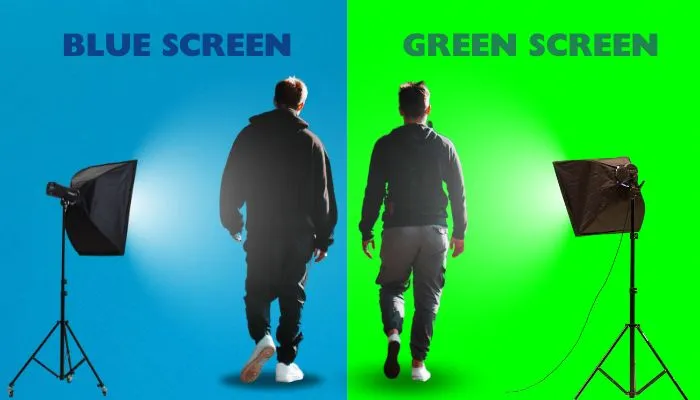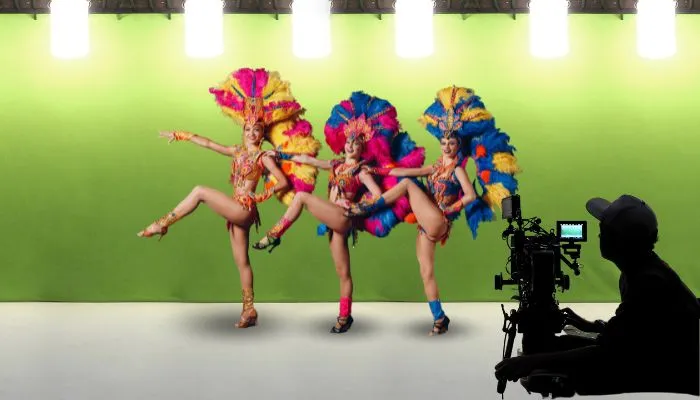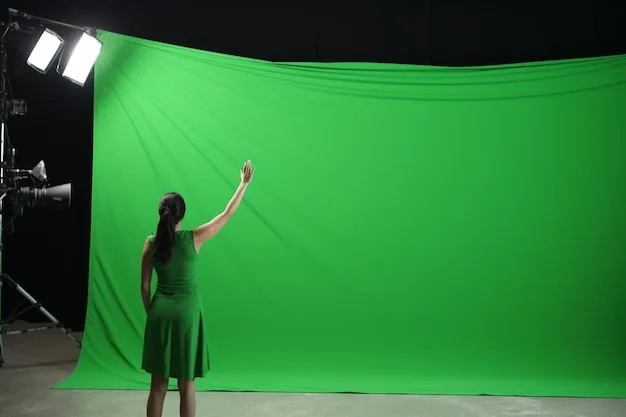Trends in Pre-Wedding…
A pre-wedding video is more than just a…

In ad filmmaking, blue and green screens have become essential tools for creating visually stunning effects. These techniques allow filmmakers to insert any background they want, transporting viewers to different worlds, eras, or even fantasy realms. But how do you choose between a blue screen and a green screen for your project? This guide will help you understand the differences and make an informed decision.
Both blue screen and green screen technology involve filming a subject in front of a solid-coloured background, which is then digitally replaced with any image or scene desired. This technique, known as chroma keying, is a staple in the video production agency world, enabling filmmakers to create dynamic and engaging content without needing elaborate sets or locations.

Green screens are more commonly used in ad filmmaking for several reasons. Green is less likely to match clothing and skin tones, reducing the risk of the subject blending into the background. Additionally, digital cameras are more sensitive to green, making it easier to achieve a clean key. This results in sharper and more precise composites.
Also Check: The Ultimate Guide to Perfecting Camera Shots for Impactful Filmmaking
While green screens are popular, there are situations where a blue screen might be the better choice. Blue screens are ideal for filming scenes with a lot of green elements, like outdoor environments or costumes. They are also less reflective than green screens, which can be beneficial when dealing with shiny objects or surfaces. In a video production agency, the choice between blue and green screens often depends on the specific needs of the project.
Lighting is a critical factor in chroma keying. Uneven lighting can cause shadows or colour spill, making it difficult to achieve a clean key. Green screens generally require less lighting than blue screens, which is another reason they are preferred in ad filmmaking. However, proper lighting setup is crucial regardless of the screen colour to ensure high-quality results.
The subject and wardrobe can influence your choice between blue and green screens. For instance, if your actors are wearing green costumes or have green props, a blue screen would be more suitable to avoid blending issues. Similarly, if blue elements are prominent in the scene, a green screen is the better option. Film production services often consider these factors when planning shoots to ensure seamless integration of the subject and background.
In post-production, green screens are typically easier to work with because of their higher luminance. This higher luminance means the green channel in digital cameras is more prominent, allowing for cleaner and more precise keying. However, modern software tools have advanced significantly, making it easier to work with both blue and green screens. Video production agencies often have skilled editors who can handle screen colour efficiently.
Cost can also play a role in deciding between blue and green screens. Green screens are generally more cost-effective due to their widespread use and lower lighting requirements. In contrast, blue screens might incur additional costs for lighting and potential post-production challenges. For ad filmmaking, where budget constraints are common, green screens often provide a more economical solution.
Several blockbuster movies and commercials have used both green and blue screens to create spectacular effects. For example, the “Harry Potter” series extensively used green screens to bring magical scenes to life, while “The Lord of the Rings” trilogy used blue screens for certain complex shots involving green elements like the lush landscapes of Middle-earth. Film production services often draw inspiration from these successful uses to determine the best approach for their projects.
When it comes to choosing between a blue screen and a green screen, the expertise of a seasoned production house can make all the difference. Skittles Video Productions, the premier video production agency in Delhi, excels in both techniques, providing top-notch film production services. Their team of professionals has extensive experience in handling various chroma key projects, ensuring that your film or ad stands out with seamless and stunning visuals.

Skittles Video Productions combines technical expertise with creative vision, making them the go-to video production agency in Delhi. Whether you need green screen or blue screen services, they offer tailored solutions to meet your specific needs. Their state-of-the-art equipment and skilled team ensure high-quality results, helping you achieve your creative goals.
Conclusion
Choosing between a blue screen and a green screen depends on various factors, including the project’s specific requirements, lighting conditions, subject matter, and budget. Both techniques have their advantages and can be used effectively in ad filmmaking and other visual storytelling mediums. Understanding the differences and applications of each will help you make an informed decision for your next project. In 2023, the global market for visual effects was valued at approximately $15.5 billion and is expected to grow at a compound annual growth rate (CAGR) of 12.7% from 2024 to 2030. This growth highlights the increasing demand for high-quality chroma-key work in film and advertising. So, if you’re looking to create impactful visuals, consider partnering with Skittles Video Productions, the best film production services provider in Delhi. Their expertise in both blue screen and green screen technology will ensure your project is visually stunning and professionally executed.
A pre-wedding video is more than just a…
The digital world is evolving rapidly. Brands need…
E-commerce is booming. But with so many online…